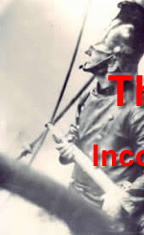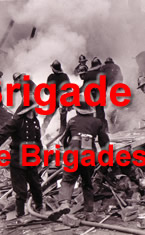Mi Amigo |
 |
 Picture of a typical B-17 Flying Fortress of the same period |
As dusk fell on 22 February 1944, a B-17 Flying Fortress (Mi Amigo) of the 8th Air Force fell from the sky over Sheffield, and crashed in woodland at the edge of a city park. In spite of the efforts of townsfolk, none of its crew of ten could be saved.
It was just before five o'clock in Endcliffe Park. Youngsters chased their football in the failing light. They heard her before they saw her.
Some accounts say that the aircraft tried to put down in that tiny green space, but that the pilot pulled up the nose when he saw the children, and hit the hill instead. Whilst others say that it circled, that it rolled, that it clipped the trees even as it broke the cloud. Some say that the engines stuttered at the last.
If Kriegshauser's last act was to save the footballers, he carried it out by bringing the plane down too soon, rather than by over flying the field.
Mi Amigo shed her tail, and slewed to a halt among the trees, her wings and fuselage more or less intact. Fire broke out internally, but for the first couple of minutes the astonished onlookers were able to draw close. The children were shooed away, since at least one man's corpse was thrown clear, though no public record identifies him.
Some observers describe cries from within. Some say that they begged for help, and others that they pleaded with would-be rescuers to get away. One young Sheffielder said he tried to pull an airman clear, but the man's legs were trapped and the flames consumed him.
Nobody seems to have considered the possibility of live bombs being on board. It was only once the fire took hold, and ammunition began to crack and whine that the huddle of people on the hill dispersed in search of shelter. The inferno, when it came, was shocking in its intensity. An hour after the crash, as the last natural light faded away, the remains of Mi Amigo were ashes and blackened shards of metal, and all hope had gone.
The crew were:
- Lt John Kriegshauser (Missouri) - pilot
- 2nd Lt Lyle Curtis (Idaho) - co-pilot
- 2nd Lt John Humphrey (Illinois) - navigator
- 2nd Lt Melchor Hernandez (California) - bombardier (The man who named the plane)
- S/Sgt Harry Estabrooks (Kansas) - engineer and top-turret gunner
- Sgt Charles Tuttle (Kentucky) - ball-turret gunner
- S/Sgt Robert Mayfield (Illinois) - radio operator
- Sgt Vito Ambrosio (New York) - right waist gunner
- M/Sgt G. Malcolm Williams (Oklahoma) - left waist gunner
- Sgt Maurice Robbins (Texas) - tail gunner
On the day that they all died, the youngest of these men was 21 years of age and the eldest 24.
A memorial stone which, weighs half a ton is located in Endcliffe Park, it carries not one but two bronze plaques, stands about fifty metres from the café and is surrounded by ten oak trees deliberately planted to commemorate the lost airmen. In spite of this, it is deceptively easy to overlook.
The Aircraft’s Mission and the Aftermath
They called it Big Week, that third week of February 1944. The air war was coming down to a simple equation. British and American bombers strove to destroy Germany's aircraft factories, and Germany's existing fighters strove to stop them. It became clear to the Allies that mass raids might overwhelm the Luftwaffe's defensive capacity, and Big Week was intended to do just that.
By around noon on that Tuesday in February 1944, Mi Amigo and the 305th were over the coast of Denmark. The sky was blotted with the deadly black smoke-puffs of flak from 88mm anti-aircraft guns. Worse still, the cloud-cover was solid, and the bombers had little hope of locating their target. If the nature of the mission had been different, the bombers might have turned for home sooner. This time, though, it was imperative to maintain the threat, and so draw the teeth of the German fighter squadrons.
Observers from neighbouring aircraft later gave a consistent, if detached, account. For whatever reason, Mi Amigo could not effect radio communication. More than one of her engines was misfiring, and her skin was in tatters. She was having difficulty maintaining altitude, and soon began to fall behind.
There was no effective way to assist a bomber in this situation. Its crew could not bale out over water, since they would die of hypothermia within minutes if they entered the sea. The first battle was simply a matter of regaining land, and after that it would be down to luck and the skill of the pilot. The squadron leader did all that he could, by assigning one plane to try and nurse Mi Amigo home. That done, he lead the rest back to Chelveston at full speed.
The first wave of Focke Wulf 190 fighters came out of the cloud close to the formation, leaving the gunners little time to respond. Judging that maneuverability was now the most urgent need, the squadron leader jettisoned his bombs. The rest of his convoy immediately followed suit, and the unburdened bombers climbed and wheeled back out to sea. For a little while, the enemy aircraft disengaged.
Mi Amigo was now almost alone. An hour before, the clouds had probably saved her. Now they became her nemesis. A tight escort was impossible because of the risk of collision. The nursemaid lost the stricken B17 some five hundred miles off the English coast, and, after a few minutes of tentative patrolling, the search had to be abandoned. Mi Amigo, it was assumed, had lost her struggle, and had plunged into the cold sea.
Mi Amigo did not crash for another four hours. What happened in the intervening time will never be known. We can only try to piece together John Kriegshauser's dilemma from the known facts.
At some point, she went off course, her flight ending a hundred miles north of her home base. This suggests that her navigational equipment was disabled, and possibly that the two crewmen in that area of the aircraft (the navigator and the bombardier) were incapacitated. The condition of the rest of the crew is unknown, though the fact that enemy fighters appear to have been able to sit on her tail and strafe her engines might mean that the tail-gunner and ball-turret gunner had also been lost.
Kriegshauser must have been aware of another aspect of his crew's welfare, too. The six men behind the cockpit of a B17 were exposed to severe cold when flying at altitude (in fact they wore electrically heated suits for this reason). Waist-gunners in particular sometimes literally froze onto the aircraft's fabric, and so injured men who could not support themselves were prone to suffer a horrible death.
Mi Amigo's pilot may well have been faced with a dreadful choice. For the reason above, he would have wanted to fly at low altitude in warmer air. The damaged engines, on the other hand, might have denied him the power to ascend, so that the height he started with would be all he could ever have. We can surmise that the approach to the English coast was a slow, and perhaps irresistible, descent.
The condition of the engines may also explain why Mi Amigo flew so far inland (around a hundred miles) without apparently trying to make a landing. The weather conditions give a further clue. Though it was still daylight, cloud cover was complete down to about 500 feet. Kriegshauser probably judged that he would have insufficient power to abort a blind approach, and so chose instead to fly on for as long as he could, hoping that the cloud would clear. It never did.
There is an annual service on the Sunday closest to 22 February. Wreaths are laid at the crash site. The service is read in St Augustine's at Brocco Bank. The anniversary is kept by the Royal Air Force Association.






